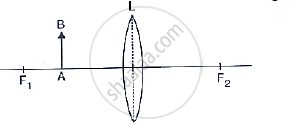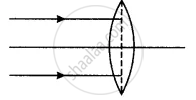Advertisements
Advertisements
प्रश्न
An illuminated object lies at a distance 1.0 m from a screen. A convex lens is used to form the image of the object on a screen placed at a distance of 75 cm from the lens. Find:
- the focal length of the lens, and
- the magnification.
उत्तर
Distance of object from screen = 1.0 m = 100 cm
v = 75 cm,
u = 100 – 75 = 25 cm = -25 cm
(i) f = ?
`1/"f" = 1/"v" -1/"u"`
= `1/75 - (1/-25)`
= `1/75 + 1/25`

`1/"f" = (1 + 3)/75 = 4/75`
f = `75/4`
f = 18.75
(ii) Magnification (m) = `v/u = 75/-25 = -3`
Magnification (m) = 3
The -ve symbol indicates that the created image is actual and inverted.
APPEARS IN
संबंधित प्रश्न
The following diagram shows an object AB and a converging lens L with foci F1 and F2. Draw two rays from the object AB and complete the diagram to locate the position of the image CD. Also mark on the diagram the position of eye from where the image can be viewed.

A lens forms an erect, magnified, and virtual image of an object. Name the device which uses this principle.
What is a magnifying glass?
Draw a neat labelled ray diagram to show the formation of an image by a magnifying glass. State three characteristics of the image.
The focal length of a convex lens is 25 cm. At what distance from the optical centre of the lens an object be placed to obtain a virtual image of twice the size?
The magnification by a lens is +0.5. Name the lens and state how are u and v related?
A convex lens produces on a screen an image twice the size of the object. If the position of image and object be interchanged, what will be the magnification then?
How is the magnification (m) produced by a lens related to the object distance (u) and the image distance (v)?
Copy and complete the following ray diagram.

Write an expression for the magnifying power of a simple microscope. How can it be increased?
